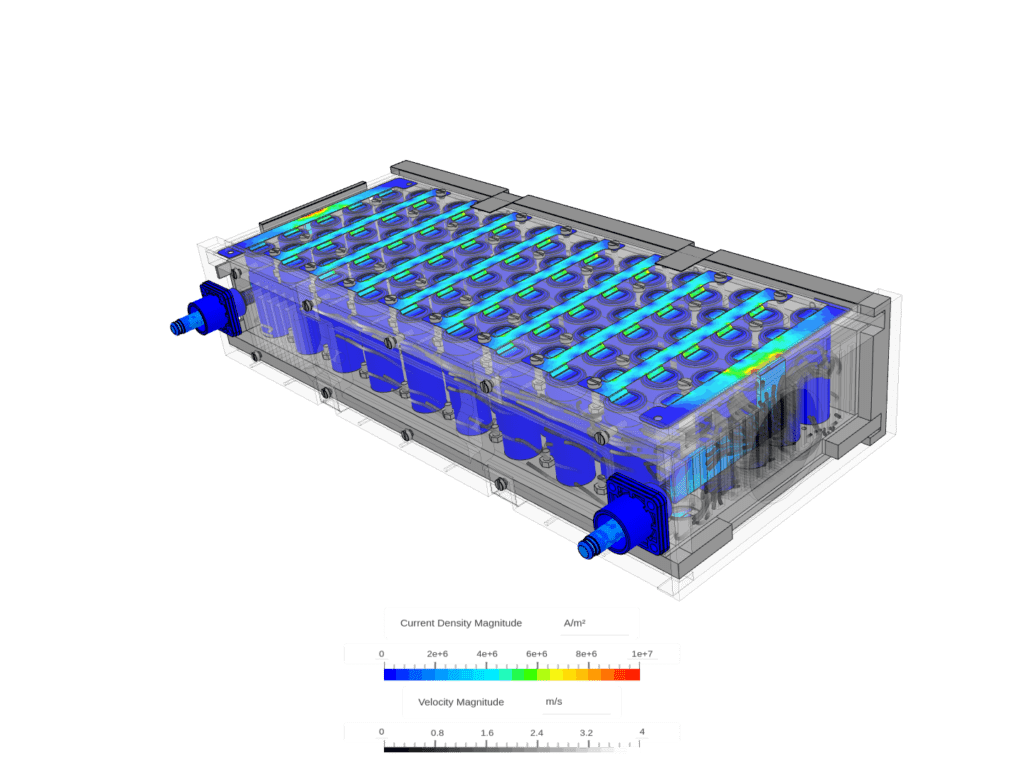Documentation
Joule heating describes the physical effect by which the passing of current through an electrical conductor releases thermal energy. The higher the electrical resistivity of the conducting material the higher the energy converted.
The effect of Joule heating can be intentional for example in electric heaters or undesired losses e.g. in busbars. The latter case requires accounting for the Joule heating effect when dealing with thermal management and cooling strategies.
SimScale allows you to define the electrical properties of conducting materials and electrical boundary conditions when enabled. The simulation takes the thermal losses of the electric circuits as input for the thermal solution and computes Electric Potential, Current Density, and Joule Heat Generation as additional solution fields.
Enabling Joule heating is mainly required or useful if:

In order to include Joule heating in your analysis, switch on the toggle in the global settings panel. The option is available for Conjugate Heat Transfer v2 and Immersed Boundary Method simulations.
Joule heating only happens when current passes through a circuit and therefore only appears in electrical conductors. When Joule heating is enabled in the global settings each material gets an Electric conductivity type. It defines if the material is Dielectric (an electric insulator not conducting any current) or if it is a conductor. Isotropic conductors have the same resistivity opposing the current in all coordinate directions while Orthotropic conductors allow for differing resistivity.
For electric conductors, Electric resistivity needs to be provided. The resistivity is a measure of how much the conducting material opposes the current flowing through it. It is the reciprocal of electrical conductivity and is more commonly used. It is given in \(Ohm*m\) which means that the further the current needs to pass through the material the higher the resulting total resistance will be and the larger the available cross-section area the lower it will turn out.
Note
Note that when you import materials from the library they come with the typical electrical properties for this material but can still be adjusted.
Fluids are always considered dielectric materials and therefore do not participate in the electrical solution.
As electric current flow is only supported for solid materials, you can add electrical conditions on wall boundary conditions. You can define either Current inflow or outflow boundary conditions in Amperes or an Electric potential in Volts on a boundary. If the wall doesn’t have any known electric conditions you can keep the default (None) which defines 0 current flow across the boundary.
Electric boundary conditions define the flow in an electric circuit and can be chosen to either
Important
It is not possible to define only inlet and outlet flow conditions even if the integrated flux into and out of the domain is in balance due to potential numerical instabilities. Defining at least one reference potential resolves the over-constrained system and will result in the expected in or outflow at the respective boundary.
The electric solution is calculated by resolving the Electric Potential in all conducting materials of the domain. The Current Density and Joule Heat Generation fields are derived from the potential solution.
$$ P = R I^2 $$
where,
\(P\) = power loss,
\(R\) = resistance,
\(I\) = current.
Know limitations are:
Last updated: June 16th, 2023
We appreciate and value your feedback.
Sign up for SimScale
and start simulating now